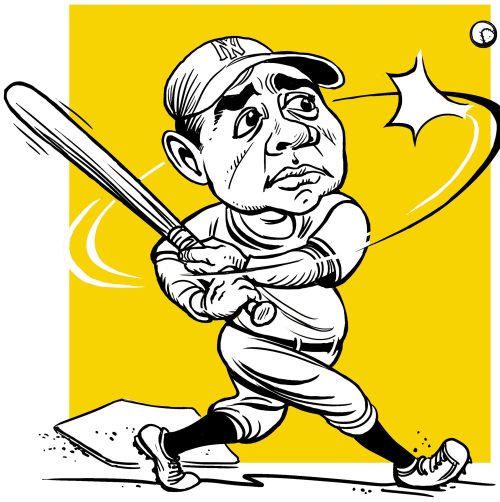
Event details
- Tuesday | March 25, 2025
- 7:00 pm - 8:30 pm
- Hughes Main Library, 25 Heritage Green Pl, Greenville, SC 29601
- 864-244-1499
Want to join us virtually? At the time of the event a link will be located here that you can click on to join us virtually.
Cost: Free

The Babe Ruth Talk is a part of the Library Talk Series celebrating a 27-year community collaboration between Greenville Chautauqua and the Greenville County Library System co-sponsoring talks about the historical figures who will appear on stage.
Events
-
25 Mar

Tim Fehler is in his 30th year as a Professor in Furman University’s Department of History. His teaching and scholarship revolve around early modern European history as he is fascinated by the intersections of Reformation-era religious, political, and social changes. History provides the lens to understand the complicated relationship between ideals and lived experience, and his research has a particular emphasis on things like poverty & charity, toleration & persecution, and the development of news reporting in the new print culture. He also has developed Furman’s History of Baseball course.
Tim’s passion for baseball emerged as he grew up in rural northern Illinois, where his English-teacher father taught him to love the game, statistics, history, and poetry of baseball. A lifelong A’s fan (he started following baseball in the early 1970s with the dominance of “the Swingin’ A’s”) and Cubs fan (he listened to or watched the daily Cubs games on the nearby WGN radio and TV stations), Tim’s love of baseball stats and stories led him to major in mathematics and history in college. Tim and his dad continued playing baseball together in an adult baseball league almost up until his dad’s death in 2013, with his dad pitching and Tim catching, making up a 118-year-old battery combo. His dad’s baseball poetry and stories have been a constant inspiration — baseball providing the vehicle for observations of everything from the commonplace to the profound, and being just plain fun.
In the annals of American sports history, no name resonates as profoundly as that of George Herman “Babe” Ruth. Known as the Sultan of Swat, Ruth wasn’t just a baseball player; he was a cultural phenomenon. His unprecedented hitting and larger-than-life personality transformed him into America’s first true national sporting celebrity. His career coincided with the rise of mass media and the Roaring Twenties, creating a perfect storm for the birth of a new kind of American idol.
Prior to Ruth, sports heroes were largely regional figures. Baseball players enjoyed a degree of fame within their cities, but their recognition rarely extended beyond. However, the early 20th century witnessed a revolution in communication. The rise of the national newspaper, the expansion of the telegraph and the burgeoning popularity of radio all served to connect people across vast distances. This newfound ability to share information on a national scale paved the way for a national sports hero to emerge.
Enter Babe Ruth. Ruth’s arrival in New York in 1920, after a trade from the Boston Red Sox to the New York Yankees, coincided perfectly with this new media landscape. His prodigious power hitting – with home run totals unheard of at the time – captured the national imagination. Newspapers across the country splashed stories of his exploits on their front pages. Sportswriters, recognizing the public’s fascination, embellished his legend, turning him into a larger-than-life figure.
Ruth, however, wasn’t a passive participant in his own fame. He understood the power of the media and actively cultivated his public image. He became a master of self-promotion, readily engaging with reporters and photographers. Ruth’s relationship with his fans was also a key component of his celebrity. He was known for his generosity, often visiting hospitals and orphanages; and he was always willing to sign autographs and engage with the public. This accessibility helped to build a loyal fan base and reinforced his image as a man of the people. Ruth’s popularity transcended the sport of baseball, making him a national icon and a symbol of the American Dream.
The Roaring Twenties provided the perfect backdrop for Ruth’s rise. The nation was booming economically, and a spirit of optimism and excess permeated the culture. Ruth’s flamboyant personality and outsized persona resonated with this mood. He wasn’t just a baseball player – he was a symbol of American exuberance and the pursuit of pleasure.
Ruth’s celebrity transcended the sports page. The commercialization of his status was a pioneering moment in the history of American sports. He was one of the first athletes to capitalize on his fame through endorsements and public appearances – his image plastered on everything from bubblegum cards to breakfast cereal. He was a popular pitchman, endorsing a variety of products, further solidifying his connection to the exploding culture of consumerism and, in so doing, becoming a household name.
Ruth’s willingness to embrace endorsements and public appearances laid the groundwork for the modern athlete-entrepreneur. While previous athletes had occasionally dabbled in endorsements, Ruth was one of the first to fully grasp the commercial potential of his fame. He understood that his image was a valuable commodity, and he actively sought opportunities to leverage it. This approach, pioneered by the Sultan of Swat, continues to define the careers of many modern athletes, who have built lucrative empires that extend far beyond their on-field performance.
His influence wasn’t limited to commerce, however. He became a social icon, attending lavish parties and hobnobbing with celebrities from the worlds of entertainment and politics. Newspapers, eager to feed the public’s insatiable appetite for details about his life, documented his every move, for the first time blurring the lines between athlete and entertainer.
Ruth’s fame also highlighted the complexities and contradictions of celebrity culture. While he was adored by millions, his personal life was often tumultuous. His struggles with excess, his stormy relationships and his eventual decline in health were all part of the public narrative. This duality of public adoration and private turmoil is a recurring theme in the lives of celebrities, and Ruth’s life was a precursor to the way modern celebrities are both idolized and scrutinized.
Despite these challenges and distractions, Ruth’s impact on American culture remains undeniable. He redefined what it meant to be a sports celebrity. Before him, athletes were admired for their skills, but Ruth became a national icon, a symbol of American success and the pursuit of dreams. He ushered in a new era of sports fandom, where athletes were not just admired for their athletic prowess but also worshiped as cultural icons. This shift, pioneered by the Big Fella, continues to define the relationship between fans and athletes today.
Babe Ruth’s legacy as a foundational figure in the history of American celebrity is undeniable, and extends far beyond the baseball diamond. He was not only a transformative athlete but also a cultural icon who helped to define the role of the celebrity in modern American society. His ability to navigate and exploit the media landscape of his time set a precedent for future generations of athletes and entertainers.
Perhaps most importantly, Ruth showed the American public the intoxicating allure of celebrity, a concept that continues to captivate us to this day. His life reflects the complexities of being a public figure in an age of media proliferation. His enduring popularity and his place in the pantheon of American icons underscore his significance not just as a baseball player but as a trailblazer in the history of American celebrity.
February 6, 1895: Born as George Herman Ruth Jr. in Baltimore, Maryland
1902: Sent to St. Mary’s Industrial School for Orphans by his parents where he learned baseball from Brother Matthias
1914: Signs his first professional baseball contract with the minor league Baltimore Orioles and later makes his Major League Baseball debut with the Boston Red Sox as a left-handed pitcher
1915: Wins his first World Series with the Red Sox
1916: Leads the American League in earned run average (ERA) as a pitcher for the Red Sox and pitches a 14-inning complete game victory in the World Series against the Brooklyn Robins
1918-1919: Begins transitioning from pitcher to full-time outfielder and hitter, leading the league in home runs with a then-record 29
1920: Traded from the Red Sox to the New York Yankees in a historic and controversial deal where he breaks his own home run record with 54 for the Yankees in his first year on the team
1923: Hits his 100th career home run and helps the Yankees win their first World Series; Yankee Stadium opens and is dubbed “The House That Ruth Built”
Mid-1920s: Participates in barnstorming tours with teammate Lou Gehrig, most notably the “Bustin’ Babes” and “Larrupin’ Lous” tour in 1927
1927: Hits an astounding 60 home runs, a record that would stand for 34 years
1932: Allegedly points to the center-field bleachers before hitting a home run in Game 3 of the World Series against the Chicago Cubs – the “called shot”
1935: Signs with the Boston Braves and hits three home runs in a game against the Pittsburgh Pirates, his final career home runs
1936: Inducted as one of the first five members of the Baseball Hall of Fame
1948: Attends the ceremony where his number 3 jersey is retired by the Yankees
August 16, 1948: Dies of cancer in New York City at the age of 53
“Never let the fear of striking out keep you from playing the game.”
“Heroes get remembered, but legends never die.”
“Every strike brings me closer to the next home run.”
“I swing big, with everything I’ve got. I hit big or I miss big. I like to live as big as I can.”
“It’s hard to beat a person who never gives up.”
“The way a team plays as a whole determines its success. You may have the greatest bunch of individual stars in the world, but if they don’t play together, the club won’t be worth a dime.”
“Baseball was, is and always will be to me the best game in the world.”
“I had only one superstition. I made sure to touch all the bases when I hit a home run.”
“If I’d just tried for them dinky singles I could’ve batted around .600.”
The Big Fella: Babe Ruth and the World He Created by Jane Leavy (2018)
Though she covers Ruth’s life, Leavy focuses primarily on the three-week barnstorming tour that he and teammate Lou Gehrig took across America in 1927. Coming after his record-setting 60 home run season, it was the biggest show in America at the time. Also focusing on his partnership with manager Christy Walsh, this gives a terrific description of Ruth’s life and times as well as a glimpse into the birth of our modern celebrity culture.
Babe: The Legend Comes to Life by Robert W. Creamer (1974)
Considered one of the classics of the sports biography genre, longtime Sports Illustrated senior writer Robert W. Creamer covers Ruth’s entire life with detail and insight. From Ruth’s early days in a Baltimore orphanage, to the glory days with the Yankees, to his later years, this biography looks behind the legend to reveal the complexities of the man that Ruth was.
The Glory of Their Times: The Story of the Early Days of Baseball Told by the Men Who Played It by Lawrence S. Ritter (1966)
This is an oral history of the game of baseball in its early days, told by the players who knew and played with Babe Ruth: Honus Wagner, Ty Cobb, and other of the earliest stars. For baseball lovers, this is an invaluable reference. Ruth is only one of the players covered, but the book benefits from having multiple views of each of its subjects, taken from the priceless stories told by the players who were there.
